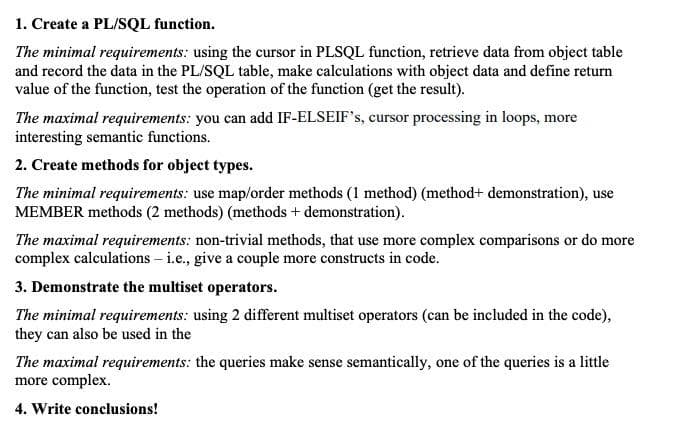1. Create a PL/SQL function. The minimal requirements: using the cursor in PLSQL function, retrieve data from object table and record the data in the PL/SQL table, make calculations with object data and define return value of the function, test the operation of the function (get the result). The maximal requirements: you can add IF-ELSEIF's, cursor processing in loops, more interesting semantic functions.
1. Create a PL/SQL function. The minimal requirements: using the cursor in PLSQL function, retrieve data from object table and record the data in the PL/SQL table, make calculations with object data and define return value of the function, test the operation of the function (get the result). The maximal requirements: you can add IF-ELSEIF's, cursor processing in loops, more interesting semantic functions.
Computer Networking: A Top-Down Approach (7th Edition)
7th Edition
ISBN:9780133594140
Author:James Kurose, Keith Ross
Publisher:James Kurose, Keith Ross
Chapter1: Computer Networks And The Internet
Section: Chapter Questions
Problem R1RQ: What is the difference between a host and an end system? List several different types of end...
Related questions
Question

Transcribed Image Text:1. Create a PL/SQL function.
The minimal requirements: using the cursor in PLSQL function, retrieve data from object table
and record the data in the PL/SQL table, make calculations with object data and define return
value of the function, test the operation of the function (get the result).
The maximal requirements: you can add IF-ELSEIF's, cursor processing in loops, more
interesting semantic functions.
2. Create methods for object types.
The minimal requirements: use map/order methods (1 method) (method+ demonstration), use
MEMBER methods (2 methods) (methods + demonstration).
The maximal requirements: non-trivial methods, that use more complex comparisons or do more
complex calculations – i.e., give a couple more constructs in code.
3. Demonstrate the multiset operators.
The minimal requirements: using 2 different multiset operators (can be included in the code),
they can also be used in the
The maximal requirements: the queries make sense semantically, one of the queries is a little
more complex.
4. Write conclusions!
Expert Solution
This question has been solved!
Explore an expertly crafted, step-by-step solution for a thorough understanding of key concepts.
Step by step
Solved in 3 steps with 1 images

Recommended textbooks for you

Computer Networking: A Top-Down Approach (7th Edi…
Computer Engineering
ISBN:
9780133594140
Author:
James Kurose, Keith Ross
Publisher:
PEARSON

Computer Organization and Design MIPS Edition, Fi…
Computer Engineering
ISBN:
9780124077263
Author:
David A. Patterson, John L. Hennessy
Publisher:
Elsevier Science

Network+ Guide to Networks (MindTap Course List)
Computer Engineering
ISBN:
9781337569330
Author:
Jill West, Tamara Dean, Jean Andrews
Publisher:
Cengage Learning

Computer Networking: A Top-Down Approach (7th Edi…
Computer Engineering
ISBN:
9780133594140
Author:
James Kurose, Keith Ross
Publisher:
PEARSON

Computer Organization and Design MIPS Edition, Fi…
Computer Engineering
ISBN:
9780124077263
Author:
David A. Patterson, John L. Hennessy
Publisher:
Elsevier Science

Network+ Guide to Networks (MindTap Course List)
Computer Engineering
ISBN:
9781337569330
Author:
Jill West, Tamara Dean, Jean Andrews
Publisher:
Cengage Learning

Concepts of Database Management
Computer Engineering
ISBN:
9781337093422
Author:
Joy L. Starks, Philip J. Pratt, Mary Z. Last
Publisher:
Cengage Learning

Prelude to Programming
Computer Engineering
ISBN:
9780133750423
Author:
VENIT, Stewart
Publisher:
Pearson Education

Sc Business Data Communications and Networking, T…
Computer Engineering
ISBN:
9781119368830
Author:
FITZGERALD
Publisher:
WILEY